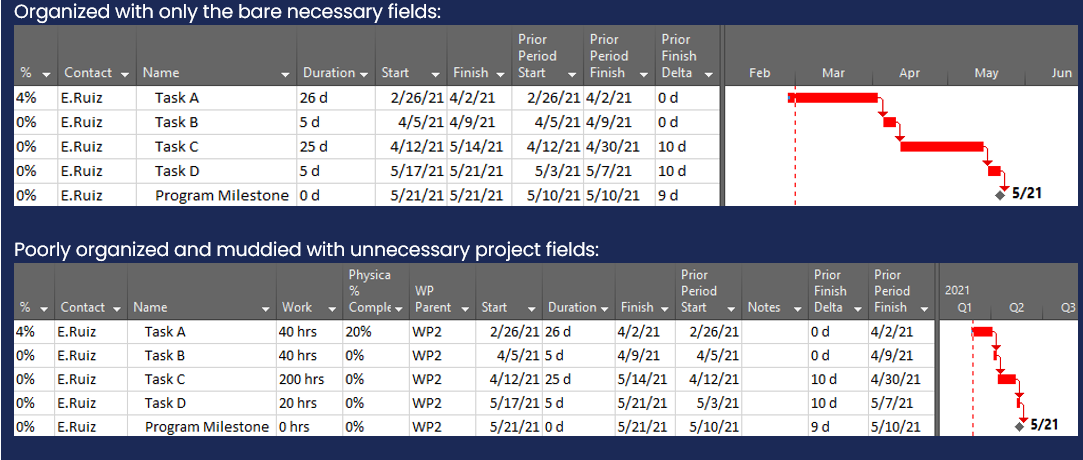Simple tips & tricks to conducting an effective Program Critical Path Review – Written by David Fennemore , Senior Consultant and Head of Consulting at Structured Solutions, Inc.
In my adventures as a scheduler and scheduling manager, the top gripe I’ve encountered from programs is about the dreaded Program Critical Path Review. It’s understandable, really. Picture this: a scheduler, eyes glued to the screen, every day meticulously dissecting every task and link of the schedule. And then, the moment of truth and sometimes the only opportunity to showcase their hard work to the program that signs their checks. No pressure, right? So, whatever you do, don’t blow it!
Effective planning & scheduling is crucial for the success of any project, especially in industries like aerospace, defense, and construction. One of the key components of this process is this review.
So, what is a Program Critical Path Review? It’s a formal review that is a collaborative session between the Program Office and project teams, where the scheduler reviews and updates the Integrated Master Schedule (IMS) in real-time. Typically held at the end of a reporting cycle, but more frequent reviews are always better. The goal is to improve project managers’ and stakeholders’ understanding of the project scope, identify schedule risks, and establish mitigations for informed strategic decisions. It often provides stakeholders with their only comprehensive view of the entire project.
Below are my Tips & Tricks for a successful Critical Path Review:
1. Perform Schedule Health & Status Checks Prior to the Review
Whether immediately following an initial baseline or after a status update, it’s a best practice to ensure that the IMS health is optimal and the status is current. Often, I have found myself in a time crunch so I choose to spend my time on correcting the issues that may impact dates and I will make the other corrections and updates later. I automate my Critical Path Pre-check by using the SSI Schedule Integrity Audits Tool.
2. Fix the Nonsense Before the Critical Path Review – Links, Durations, and Other Issues that are Obviously Wrong.
It is not uncommon during the IMS change or status process to create incorrect links or fat finger task durations. Another best practice is to review the driving paths and fix any obviously wrong durations or links prior to walking into the formal review. It seems simple but I can’t tell you how many times I have sat in a review and the critical path is a random non-critical Level of effort (LOE) task or some 10-day task that now shows a duration of 1,000 day because someone fat fingered an update – Its kind of embarrassing to the scheduler and waste everyone’s time fixing in the meeting. – Spending some time analyzing and updating the IMS independently will make the Program Review much smoother.
3. Pre-Meeting Reviews
If there have been significant changes after the status update, it’s advisable to conduct an initial critical path review with the Control Account Manager (CAM) / Point of Contact (POC) of the driving issues and attempt to resolve them. This approach can lead to one of two outcomes: 1) resolving the issue, or 2) providing the CAM/POC with early notice, allowing them time to gather valuable data that can then be presented to the program team for further action. – Nobody likes to be surprised that they are on the critical path.
4. Organizing the Critical Path Display
This tip is straightforward but crucial: Ensure that the IMS critical path display is organized for easy readability and clear visibility of schedule issues. A disorganized critical path presentation view is my #1 pet peeve, as it’s such a simple aspect to get right. A well-structured, simplified view makes it easier for those who don’t spend all day looking at schedules to understand the data. My preferred critical path view includes only the following columns: Unique Identifier (UID), Total Slack, POC, Task Name, Duration, Start, Finish, Prior Period Start, Prior Period Finish, and Finish Delta in days. Limiting the display to these columns allows me to simultaneously view the IMS details and the IMS Gantt chart, as well as to easily identify key drivers.

5. Facilitating the Meeting
Facilitating a Program Critical Path Review meeting can be as tough as teaching a cat to text, which is precisely why I stick to the strategies in points #1 to #3 to make it a tad less challenging. Picture this: a room full of CAMs, who usually vanish faster than cookies at a kids’ party when it’s time to look at the schedule, suddenly morph into schedule wizards, bombarding you all at the same time with where to click and what to change. Remember, this is your circus, and you’re the ringmaster. March into that meeting with a game plan: know exactly which schedule items to spotlight, which issues to wave a big red flag at, and what kind of guidance you need from the program to mitigate schedule issues and risk. – Be prepared, know the issues, and lead the meeting. You know this schedule better than anyone.
Conclusion
A well-executed Critical Path Review is an invaluable tool in program planning and scheduling. By investing time in thorough preparation, proactively addressing issues, presenting information in a clear and accessible manner, and steering focused discussions, the program team can dedicate their efforts resolving the complex program schedule issues. Ultimately, this paves the way for the IMS to be embraced as the primary tool for program management, ensuring a smoother journey toward project success.

